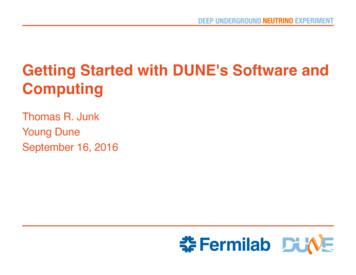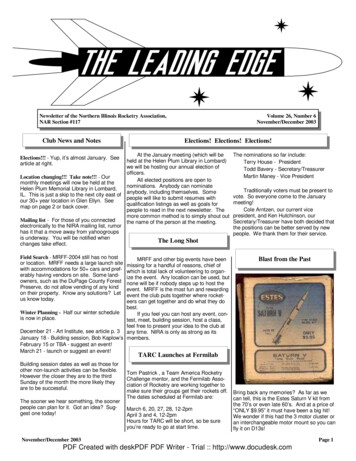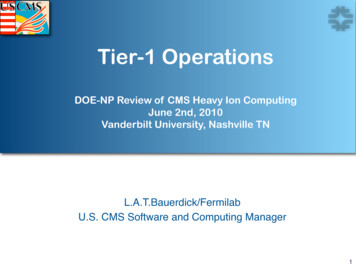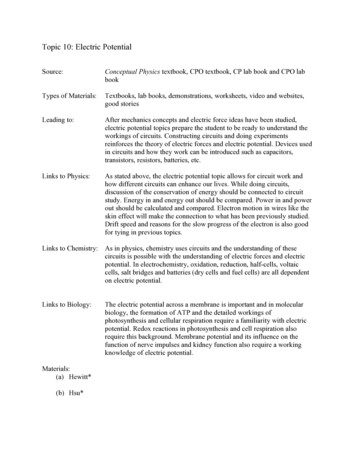
Transcription
Topic 10: Electric PotentialSource:Conceptual Physics textbook, CPO textbook, CP lab book and CPO labbookTypes of Materials:Textbooks, lab books, demonstrations, worksheets, video and websites,good storiesLeading to:After mechanics concepts and electric force ideas have been studied,electric potential topics prepare the student to be ready to understand theworkings of circuits. Constructing circuits and doing experimentsreinforces the theory of electric forces and electric potential. Devices usedin circuits and how they work can be introduced such as capacitors,transistors, resistors, batteries, etc.Links to Physics:As stated above, the electric potential topic allows for circuit work andhow different circuits can enhance our lives. While doing circuits,discussion of the conservation of energy should be connected to circuitstudy. Energy in and energy out should be compared. Power in and powerout should be calculated and compared. Electron motion in wires like theskin effect will make the connection to what has been previously studied.Drift speed and reasons for the slow progress of the electron is also goodfor tying in previous topics.Links to Chemistry: As in physics, chemistry uses circuits and the understanding of thesecircuits is possible with the understanding of electric forces and electricpotential. In electrochemistry, oxidation, reduction, half-cells, voltaiccells, salt bridges and batteries (dry cells and fuel cells) are all dependenton electric potential.Links to Biology:Materials:(a) Hewitt*(b) Hsu*The electric potential across a membrane is important and in molecularbiology, the formation of ATP and the detailed workings ofphotosynthesis and cellular respiration require a familiarity with electricpotential. Redox reactions in photosynthesis and cell respiration alsorequire this background. Membrane potential and its influence on thefunction of nerve impulses and kidney function also require a workingknowledge of electric potential.
(c) My Lab/ActivityElectric Potential*(d) WorksheetElectric Potential Worksheet*(e) DemonstrationsPotential Difference and Equipotential(f) Websites and Videos1. The Ohm Zone Lab Sim (Shockwave)2. Powerhouse Lab Sim (Shockwave)3. PhET Circuit Sims (Java)4. www.library.advanced.org/10796/ch12/ch12.htm(This site compares the gravitational force field to the electric force field and theirderivations. This site is mainly for the teacher.)(g) Good Stories1. Alessandro Giuseppe Antonio Anastasio Volta (1745-1827)2. Michael Faraday – The Fading of a Genius3. Michael Faraday – The Early Years
Topic 10: Electric Potential DemonstrationDemonstration of Potential Difference and EquipotentialShowing potential energy difference for the earth’s gravitational field can be shown visually.Showing electrical potential (energy) difference is harder to visually show and understand. I liketo use the gravity analogy to establish the electrical potential difference concept.So, first:(A)(a) Drop an object (ex: baseball) from rest from20 cm above a pie tin on spacers. Observe.(b) Reposition the pie tin and spacers to adifferent location and again drop the ballfrom 20 cm. Observe.(c) Drop the same ball onto pie tin 2,but from 100 cm above pie tin 2 andobserve.The noise from the two drops at 20 cm will look and sound about the same. The look and soundfrom 100 cm will be more violent and noisy since the system has five times more energy!The GPE difference is GPE mg ! h mg (100 cm – 20 cm) mg (80 cm). This represents thepotential difference in both trials and what is observed is the increased violence and sound atimpact. This PD is given to the ball-earth system by the gravitational force field as the force ofgravity acts through the displacement.The two trials at 20 cm drop are the same potential difference since ! h 20 cm in both cases.The release points for the two 20 cm trials are “equipotential,” or at the same starting energy.(B) The Electrical Analogy for Potential Difference (Electrical):Connect a DC 6V battery to a 6V bulb. Observe. Touch the bulb. Observe.The bulb gives off light (energy) and heat (HOT), which is also energy. This energy of light andheat at the bulb comes from the battery’s “electric force field” that drives the charge (electrons)through the bulb.
Since potential difference is measured in volts, use a DC voltmeter to measure the batteryvoltage (potential energy gain) while in operation and the bulb’s voltage (potential energy drop;voltage drop).Since voltage is a measure of the ENERGY per CHARGE, (ENERGY),(CHARGE)the energy delivered to the circuit by the charges matches the energy used by the circuit (voltagegain equals voltage drop) around the circuit. This is just the conservation of energy.(C) Showing “Equipotential and Potential Difference”DEMO1. Obtain a clear glass rectangular dish about 15 cm by 30 cm. A cooking dish wouldwork or buy a ready-made dish with a grid from a science supply house.2. Obtain a clear plastic sheet with a grid. Place the grid on an overhead projector and thedish on the grid.3. Obtain two metal strips about 4 cm x 10 cm (electrodes) and vertically secure themparallel to each other at opposite ends of the dish.4. Pour about 1 cm of salt water in the dish to cover the lower part of the electrodes.5. Connect a variable DC power supply (0-20 V) to the electrodes in the dish using leads.See sketch.Top ViewOverheadGrid with Dishon TopElectrodesDC0-20 V
6. Enlarged grid/electrodes with reference points:abecfdgSet the energyper charge (orvoltage) at 10 Vacross the twoelectrodes.h7. Use a DC voltmeter to measure the “electrical potential difference (PD)” with the twovoltmeter probes at the following pair of points:a and c: PD b and d: PD (a)e and g: PD f and h: PD Now do:a and f: PD e and d: PD (b)a and h: PD Now do:b and e: PD c and f: PD d and g: PD (c)
Results:Since all the “change in positions, displacements” for all of (a) and (b) are TWOSPACES, the electrical potential energy difference (PD) IS THE SAME!However, in (c), the two points chosen for each trial are at the same energy so theENERGY/CHARGE or potential difference (voltage) is equal to ZERO!For (c), the chosen pairs are at the same energy, thus, EQUIPOTENTIAL.
Alessandro Giuseppe Antonio Anastasio Volta (1745-1827)On November 3, 1776, while on summer holiday on Lake Maggiore, his boat wentalongside the reeds. Volta began to poke the muddy bottom of the lake with a stick and saw lotsof gassy bubbles rise to the surface and burst. He collected some of this gas and discovered thatit was inflammable. He called it “inflammable air from marshlands.” Today the gas is known asmethane.In Volta’s time electricity and chemistry were considered very closely related. Thepossibility of sparking off an explosive mixture of gas led Volta to construct an interestinggadget later called Volta’s Pistol. This was a glass container made in the shape of a pistol thatwould contain an inflammable gas, which was ignited by an electrical spark. This contraptionwas surprisingly effective firing a lead ball and denting wood at a distance of five meters.In that same year Volta had the idea of using a long metal wire, insulated from the groundby wooden boards, for conveying an electrical signal. Volta had imagined an electrical signal,generated from a Leyden jar, passing through the wire, into a nearby stream and traveling downstream to a nearby village and igniting an inflammable gas in the Volta Pistol. The concept of thetelegraph had been born.Volta’s Pistol continued to be used in determining the relative percentage of oxygen ininflammable airs by the force they generated when exploded.In 1801 Napoleon Boneparte invited Alessandro to Paris to confer upon him the title ofCount and proclaim him a senator of Italy.
Michael Faraday – The Fading of a GeniusIn the 1830’s, after several years of very concentrated work, Michael’s health let himdown suddenly and dramatically. He began to suffer giddy spells and even more frighteningly,complete lapses of memory. Eventually, although reluctantly, he listened to his doctors and tooka complete nine-month break in Switzerland. On his return he did no more work at all for fouryears and then only began to research again at a very slow pace.Then from 1845 onwards, Faraday’s health recovered almost miraculously and anotherseventeen years of brilliant research emerged from his laboratory, although his memory wasnever again as good. He wrote himself copious notes to make sure he could remember what hewas doing, making it possible for him to continue as a respected and successful scientist.However, his memory, which had given him trouble for years, increasingly, let him down. Hecould remember the past but not the present. He dare not work in the same areas of research asother people because he could not remember what they had done and feared he might againappear to steal ideas.“My memory wearies me greatly in working; for I cannot remember from day to day theconclusions I came to. I do not remember the order of things or even the facts themselves.”From his retirement in 1865, Faraday deteriorated rapidly. Toward the end of his life hewas rarely lucid and unable to do anything for himself, spending most of his time sitting in achair staring vacantly into space. Finally, on August 25, 1867, Faraday died, still sitting quietlyin his chair.timelinescience – Resources
Michael Faraday – The Early YearsAs a child, Michael Faraday’s formal education was cut short by a series of dramaticevents. Unfortunately for young Michael, the educational philosophy of the day was “Spare thewhip, spoil the child.” This combined with a speech impediment that prevented him frompronouncing his R’s, lead to a traumatic experience, which Michael would never forget. Ongoingfriction between the schoolmaster and young Michael finally came to a head. One morning theschoolmaster beat the child so severely that he could not move off the classroom floor. Enragedat seeing this, Michael’s older brother Robert (Wobert as Michael called him) leapt from hisdesk, flew out of the school and raced home. About an hour later Robert reappeared at the schoolwith the boy’s mother. As they entered the classroom, young Michael was still lying on the floor.Mrs. Faraday became furious. She picked up the boy and marched out of the school with Roberttrailing behind while lashing out at the schoolmaster. Michael Faraday had left the publiceducation system forever. For the rest of his life, Michael Faraday was a self-taught man.Internet Sources
Electric Potential Worksheet* (e) Demonstrations Potential Difference and Equipotential (f) Websites and Videos 1. The Ohm Zone Lab Sim (Shockwave) 2. Powerhouse Lab Sim (Shockwave) . potential difference in both trials and what is observed is the increased violence and sound at impact. This PD is given to the ball-earth system by the .
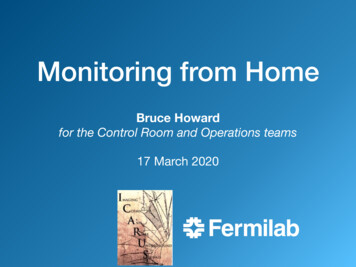
![2 CHAPTER 1 [Topic 1] Coulomb's law, electrostatic field and electric .](/img/52/physics.jpg)


